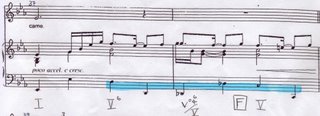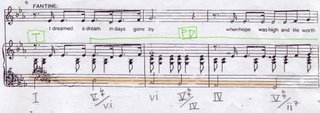Fig 2a

As said earlier, the descending chromatic progression in bars 37-38 is used as a transition from EbMajor to FMajor. The style of this chromatic descent is similar to the ground bass progression, except that octave leaps are used to add interest. A secondary dominant chord is also used to ensure the smooth transition, and it is a lament bass. (refer fig.2a)
Fig 2b

In the final bars, the descending base line takes up more of a chordal structure rather than just a single descending line as seen throughout the piece. It is more stable and allows the cadence at the end to sound out more. This gives a strong sense of closure. (refer fig.2b)
Fig 2c

Here's the analysis of the opening phrase using secondary dominants. Can it be analysed this way too even though they are passing in function? (refer fig.2c)
Fig 2d

About the phrase structure, this piece is made up of symmetrical and double periods. (refer fig 2d)


3 comments:
Hiya!
*Refering to fig 2c*
I agree with you that they are passing in nature. But since they are passing, perhaps there's no need to label them?
I also don't think that tonicisation takes place here. It's just passing harmony. V(64) chords are not really strong chords that have a tendecy to go to I. I'm not sure why / how you analysed the chords as V(64) chords too.
hey joyce!
my gosh its been ages since we've seen each other.
AND GOLLY.
what exactly are you studying? seriously, you really look at the scores and analyze the chords?!!
haha funny i dont study this in vienna. what we do here is study weird, chordal stuff and like notation from different periods, and how cosmology affected music and bla bla. the only time i analyze a score is when im playing it.
then again, everything's in german so for all i know the prof may be saying one thing but im understanding another. hahaha.
but anyway girl, hope you are good! perhaps one day we will get to meet in singapore, as music teachers!
omgg how scary, think miss low.
ew.
Jean is right about the passing harmonies and that there is no tonicization in Fig. 2c but the explanation for the latter should be that the first two of these chords are minor chords and the 3rd, though being a major chord, has a major 7th. The reading should be:
I - P4/2 - vi - P4/2 - IV - P4/2
Post a Comment